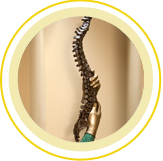Ben Moore: Isthmic Spondylolisthesis
Michelle Moore: Degenerative Spondylolisthesis
Max W. Cohen, MD, FAAOS, treated a mother and son, Michelle and Ben Moore, who had different forms of the same condition, spondylolisthesis, which is a slippage of one vertebra onto the other. Spondylolisthesis literally means “vertebra” (spondylo) “to slip” (listhesis) in its Greek origins.
Ben had isthmic spondylolisthesis. Commonly found in adolescent athletes (such as gymnasts, football players and divers), this type of spondylolisthesis occurs after a stress fracture in the area of the vertebra called the pars. The fracture itself is called spondylolysis. Over time, the fractured bone can shift forward. When that happens, it is called spondylolisthesis – and it may or may not cause symptoms.
“There’s a genetic component to this type of spondylolisthesis,” Dr. Cohen says. “The thinnest part of the vertebra is what breaks. That allows the whole vertebral body to shift forward. In most cases, surgery is not necessary for teens with spondylolisthesis.”
“We can treat most cases of spondylolisthesis in kids with a back brace and physical therapy,” Dr. Cohen says. “However, there are some cases where the slippage progresses to the point where surgery is needed. That’s what happened to Ben.”
Ben’s mother, Michelle, had degenerative spondylolisthesis.
“Degenerative spondylolisthesis occurs more in the 40s and 50s age groups,” Dr. Cohen says. “It usually occurs in women, and we’re not sure why that is. It could have something to do with hormonal differences in ligaments.”
In both isthmic and degenerative spondylolisthesis, a shifting of the bone causes the problem.
“But in isthmic (the kind Ben had) the shifting is due to a crack in the pars, so only the front of the bone shifts forward,” says Dr. Cohen. “In degenerative spondylolisthesis, there’s an instability of the entire segment due to degeneration of the joint. The joint is arthritic and incompetent, and the whole bone, front and back, shifts forward.”
“Degenerative spondylolisthesis often occurs along with spinal stenosis, a narrowing of the spinal canal,” Dr. Cohen says.
Spinal fusion is often used to treat both types of spondylolisthesis. Spinal fusion is a complex procedure performed under anesthesia, in which the surgeon joins segments of the spine together. Bone grafts are laid over the vertebra, with splints fashioned from rods, screws and other instrumentation used to hold the grafts in place until they heal. Dr. Cohen has extensive experience with the procedure.
“There are certain disorders of the spine that do well with fusion,” he says. “Spondylolisthesis is one of those.”



